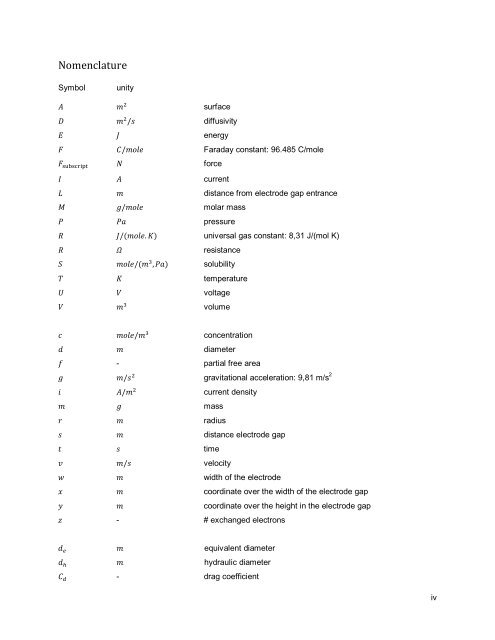A bubble curtain model applied in chlorate electrolysis
A bubble curtain model applied in chlorate electrolysis
A bubble curtain model applied in chlorate electrolysis
You also want an ePaper? Increase the reach of your titles
YUMPU automatically turns print PDFs into web optimized ePapers that Google loves.
mR equivalent<br />
mR hydraulic<br />
Nomenclature<br />
Symbol<br />
unity<br />
A m 2 surface<br />
D m 2 /s diffusivity<br />
E J energy<br />
F C/mole Faraday constant: 96.485 C/mole<br />
F subscript N force<br />
I A current<br />
L m distance from electrode gap entrance<br />
M g/mole molar mass<br />
P Pa pressure<br />
R J/(mole. K) universal gas constant: 8,31 J/(mol K)<br />
R Ω resistance<br />
S mole/(m 3 , Pa) solubility<br />
T K temperature<br />
U V voltage<br />
V m 3 volume<br />
c mole/m 3 concentration<br />
d m diameter<br />
f - partial free area<br />
g m/s 2 gravitational acceleration: 9,81 m/s 2<br />
i A/m 2 current density<br />
m g mass<br />
r m radius<br />
s m distance electrode gap<br />
t s time<br />
v m/s velocity<br />
w m width of the electrode<br />
x m coord<strong>in</strong>ate over the width of the electrode gap<br />
y m coord<strong>in</strong>ate over the height <strong>in</strong> the electrode gap<br />
z - # exchanged electrons<br />
d e<br />
R<br />
d h<br />
R<br />
diameter<br />
diameter<br />
C d - drag coefficient<br />
iv















